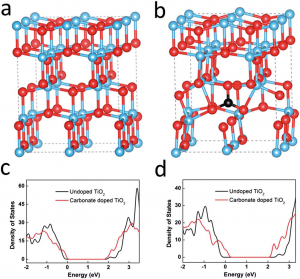 A simple “one-pot” solvothermal method has been developed to prepare high-surface-area mesoporous TiO2 microspheres in order to extend the light absorption from the ultraviolet to the visible region of the solar spectrum.
A simple “one-pot” solvothermal method has been developed to prepare high-surface-area mesoporous TiO2 microspheres in order to extend the light absorption from the ultraviolet to the visible region of the solar spectrum.
By Martina Congiu
Titanium dioxide (TiO2) is a wide bandgap semiconductor, extensively studied for photocatalysis because nontoxic, abundant, stable and photoactive. Unfortunately, bare TiO2 absorbs photons only in the ultraviolet, hence the need to find suitable dopants to enhance its absorption in the visible region.
The new nonaqueous solvothermal method carried out by Liu and co-workers, shows how it is possible to synthesize carbon-doped microspheres with high specific surface area, tunable pore diameter and grain size, high crystallinity, well-defined morphology and high visible light absorption.
Furthermore, the new material was tested as solid-state photocatalyst under visible light irradiation. The experiment showed that doped-TiO2 microspheres created with this new method have an hydrogen production rate three times higher than commercial TiO2 nanoparticles.
Interested in a better understanding about this field? Read more from the Communication:
Doping high-surface-area mesoporous TiO2 microspheres with carbonate for visible light hydrogen production
Bin Liu, Li-Min Liu, Xiu-Feng Lang, Hsin-Yi Wang, Xiong Wen (David) Lou and Eray S. Aydil
DOI: 10.1039/C4EE00472H, Communication










